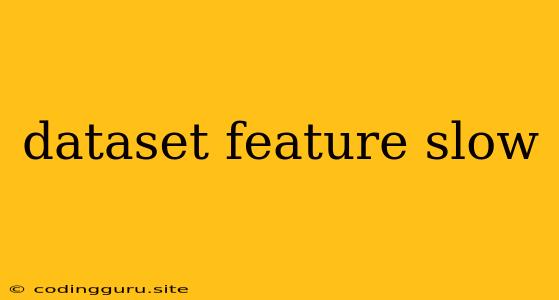Dealing with Slow Feature Extraction from Datasets
Working with large datasets is a common practice in the realm of machine learning. However, extracting features from these datasets can sometimes be a slow and tedious process, significantly impacting the efficiency of your model development. This article delves into the common causes of slow feature extraction and explores practical solutions to overcome these challenges.
Why is Feature Extraction So Slow?
The speed of feature extraction depends on several factors:
- Dataset Size: Larger datasets naturally take longer to process.
- Data Complexity: The more complex the data, the more time it takes to extract meaningful features.
- Feature Engineering Techniques: Some feature engineering techniques, like image processing or text analysis, are inherently more computationally demanding.
- Hardware Limitations: Insufficient processing power or memory can significantly slow down feature extraction.
Identifying the Bottleneck
Before diving into solutions, it's crucial to identify the source of the slowness. Here's a breakdown of common scenarios:
- Data Loading: If your dataset is large and you're loading it into memory every time you need to extract features, this process can take a significant amount of time.
- Feature Calculation: Some feature calculations are computationally intensive, especially those involving complex mathematical operations or iterative processes.
- I/O Operations: Writing features to disk or retrieving them from external sources can slow down feature extraction if the I/O operations are not optimized.
Strategies to Speed Up Feature Extraction
Here are several strategies to tackle slow feature extraction:
1. Optimize Data Loading:
- Chunking: Load data in smaller chunks to reduce memory pressure and improve processing speed.
- Data Caching: Store frequently used data in memory to avoid repetitive loading.
- Data Preprocessing: Perform data cleaning and transformation tasks beforehand to reduce the workload during feature extraction.
- Data Compression: Compress data to reduce storage space and improve loading times.
2. Enhance Feature Calculation:
- Vectorization: Utilize vectorized operations in libraries like NumPy to perform computations much faster.
- Parallel Processing: Utilize multi-core CPUs or GPUs to parallelize feature calculation tasks.
- Approximate Algorithms: Consider using approximate algorithms for complex features if a small loss in accuracy is acceptable for significant speed gains.
3. Improve I/O Operations:
- Disk Caching: Use disk caches to speed up access to frequently accessed data.
- Database Optimization: If your data is stored in a database, optimize the database for fast retrieval.
- Network Optimization: Optimize network connections to minimize data transfer times.
4. Hardware Considerations:
- Increased RAM: Allocate more RAM to handle large datasets efficiently.
- Faster SSD: Use solid-state drives (SSDs) for faster data access compared to traditional hard drives.
- GPU Acceleration: Leverage the power of GPUs for computationally intensive tasks like image processing or deep learning.
5. Feature Selection:
- Dimensionality Reduction: Apply dimensionality reduction techniques like Principal Component Analysis (PCA) or t-SNE to reduce the number of features and improve efficiency.
- Feature Importance Analysis: Use feature importance techniques to identify the most relevant features and discard unnecessary ones.
Example: Optimizing Text Feature Extraction
Imagine you're extracting features from a large text dataset using a TF-IDF (Term Frequency-Inverse Document Frequency) approach. You can optimize this process using the following steps:
- Chunking: Load the text data in smaller batches instead of loading the entire dataset into memory.
- Vectorization: Utilize libraries like scikit-learn's
TfidfVectorizerto vectorize the text efficiently. - Parallel Processing: Use libraries like
joblibto parallelize the vectorization process across multiple cores. - Disk Caching: Cache the generated TF-IDF vectors to avoid repetitive calculations.
Conclusion:
Addressing slow feature extraction requires a systematic approach involving data loading optimization, efficient feature calculation, improved I/O operations, hardware upgrades, and careful feature selection. By implementing these strategies, you can significantly boost the speed of your feature extraction process, enabling faster model training and deployment. Remember to analyze your specific needs and tailor your optimization techniques accordingly.
